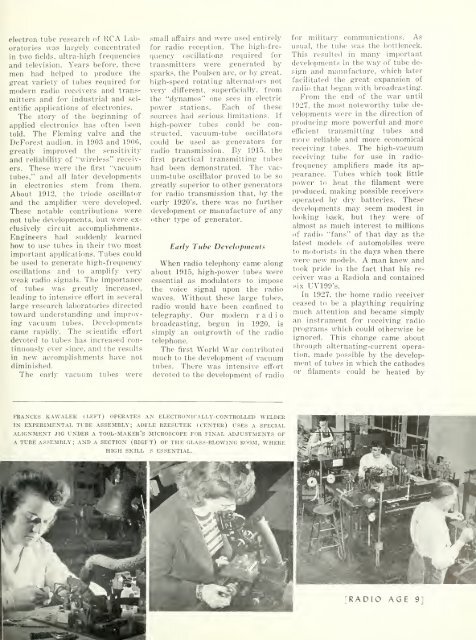Radio Age - 1944, January - 36 Pages, 3.3 MB ... - VacuumTubeEra
Radio Age - 1944, January - 36 Pages, 3.3 MB ... - VacuumTubeEra
Radio Age - 1944, January - 36 Pages, 3.3 MB ... - VacuumTubeEra
Create successful ePaper yourself
Turn your PDF publications into a flip-book with our unique Google optimized e-Paper software.
electron tube research of RCA Laboratories<br />
was larfrely concentrated<br />
in two fields, ultra-hiRh frequencies<br />
and television. Years before, these<br />
men had helped to produce the<br />
great variety of tubes required for<br />
modern radio receivers and transmitters<br />
and for industrial and scientific<br />
applications of electronics.<br />
The story of the beginning of<br />
applied electronics has often been<br />
told. The Fleming valve and the<br />
DeForest audion, in 1903 and 1906,<br />
greatly improved the sensitivity<br />
and reliability of "wireless" receivers.<br />
These were the first "vacuum<br />
tubes," and all later developments<br />
in electronics stem from them.<br />
About 1912, the triode oscillator<br />
and the amplifier were developed.<br />
These notable contributions were<br />
not tube developments, but were exclusively<br />
circuit accomplishments.<br />
Engineers had suddenly learned<br />
how to use tubes in their two most<br />
important applications. Tubes could<br />
be used to generate high-frequency<br />
oscillations and to amplify very<br />
weak radio signals. The importance<br />
of tubes was greatly increased,<br />
leading to intensive effort in several<br />
large research laboratories directed<br />
toward understanding and improving<br />
vacuum tubes. Developments<br />
came rapidly. The scientific effort<br />
devoted to tubes has increased continuously<br />
ever since, and the results<br />
in new accomplishments have not<br />
diminished.<br />
The early vacuum tubes were<br />
small affairs and were used entirely<br />
for radio reception. The high-frequency<br />
oscillations required for<br />
transmitters were generated by<br />
sparks, the Poulsen arc, or by great,<br />
high-speed rotating alternators not<br />
very different, superficially, from<br />
the "dynamos" one sees in electric<br />
power stations. Each of these<br />
sources had serious limitations. If<br />
high-power tubes could be constructed,<br />
vacuum-tube oscillators<br />
could be used as generators for<br />
radio transmission. By 1915, the<br />
first practical transmitting tubes<br />
had been demonstrated. The vacuum-tube<br />
oscillator proved to be so<br />
greatly superior to other generators<br />
for radio transmission that, by the<br />
early 1920's, there was no further<br />
development or manufacture of any<br />
other type of generator.<br />
Early Tube Derelopntents<br />
When radio telephony came along<br />
about 1915, high-power tubes w^ere<br />
essential as modulators to impose<br />
the voice signal upon the radio<br />
waves. Without these large tubes,<br />
radio would have been confined to<br />
telegraphy. Our modern radio<br />
broadcasting, begun in 1920, is<br />
simply an outgrowth of the radio<br />
telephone.<br />
The first World War contributed<br />
much to the development of vacuum<br />
tubes. There was intensive effort<br />
devoted to the development of radio<br />
for military communications. As<br />
usual, the tube was the bottleneck.<br />
This resulted in many important<br />
developments in the way of tube design<br />
and manufacture, which later<br />
facilitated the great expansion of<br />
radio that began with broadcasting.<br />
From the end of the war until<br />
1927, the most noteworthy tube developments<br />
were in the direction of<br />
producing more powerful and more<br />
efficient transmitting tubes and<br />
more reliable and more economical<br />
receiving tubes. The high-vacuum<br />
receiving tube for use in radiofrequency<br />
amplifiers made its appearance.<br />
Tubes which took little<br />
power to heat the filament were<br />
liroduced, making possible receivers<br />
operated by dry batteries. These<br />
developments may seem modest in<br />
looking back, but they were of<br />
almost as much interest to millions<br />
of radio "fans" of that day as the<br />
latest models of automobiles were<br />
to motorists in the days when there<br />
were new models. A man knew and<br />
took pride in the fact that his receiver<br />
was a <strong>Radio</strong>la and contained<br />
six UV199's.<br />
In 1927, the home radio receiver<br />
ceased to be a plaything requiring<br />
much attention and became simply<br />
an instrument for receiving radio<br />
programs which could otherwise be<br />
ignored. This change came about<br />
through alternating-current operation,<br />
made possible by the development<br />
of tubes in which the cathodes<br />
or filaments could be heated by<br />
FRANCES K.^W.ALEK (LEFT) OPERATES AN ELECTRONICALLY-CONTROLLED WELDER<br />
IN EXPERI.MENTAL TIBE ASSE<strong>MB</strong>LY; ADELE RZESUTEK (CENTER) USES A SPECIAL<br />
ALIGNMENT JIG UNDER A TOOL-MAKER'S MICROSCOPE FOR FINAL ADJUSTMENTS OF<br />
A TUBE ASSE<strong>MB</strong>LY; AND A SECTION (RIGE T) OF THE GLASS-BLOWING ROOM, WHERE<br />
HIGH SKILL S ESSENTIAL.<br />
[RADIO AGE 9]
















